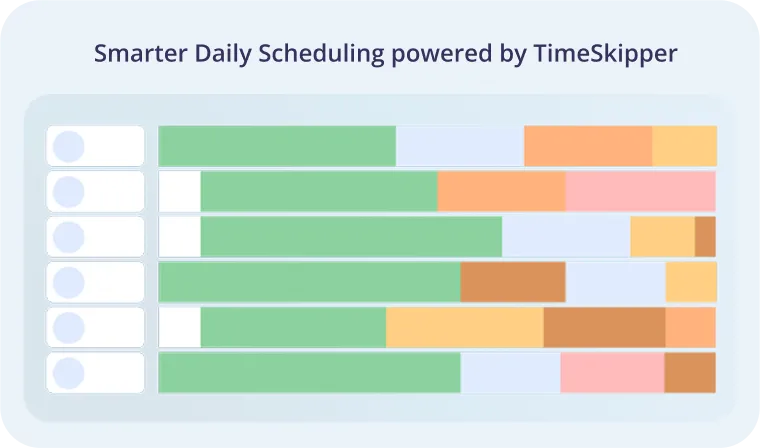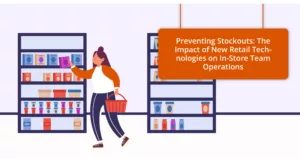The scene is all too familiar: a store manager juggling with their trusty old Excel file to set everyone’s shifts. Once the go-to tool, this software is now showing its limits. With lower sales volumes, increasingly demanding customers, and the daily wave of unforeseen issues, retail staff scheduling has turned into a real headache.
Because building a schedule isn’t just about assigning hours. It’s about aligning shifts with the actual workload. Knowing who does what, where, and when with the right number of staff, at the right time, in the right place.
This article isn’t about optimizing employees‘ hours, plenty of experts have already covered that. What we want to explore is something deeper: how to schedule and steer daily activities so that every hour worked truly counts.
So how do you make sense of it all and coordinate your team efficiently?
Follow the guide!
From excel to precision retail: a new approach to retail staff scheduling
Excel is no longer enough
For years, retail moved forward without too much friction.
But today, the game has changed: fierce competition, declining volumes, market consolidation, and the growing influence of digital and AI. To stay competitive, stores must transform and that starts with more precise operational management, grounded in a clear understanding of store flows: deliveries, customers traffic, stockouts, e-commerce, promotional campaigns…
And at this point, even an Excel wizard can’t keep up. Spreadsheets quickly show their limits when it comes to anticipating the unexpected, adjusting in real time, or visualizing the balance between workload and available resources.
The result? A lot of time spent… with little return. It’s time to rethink retail scheduling.
Precision retail: the new norm in store operations
As growth slows and every variable matters, retail has become a matter of precision. Thanks to artificial intelligence and data, retailers can now anticipate traffic, adjust resources, and seize every opportunity with agility.
But let’s be clear: these management software are only effective if they’re designed for the realities of the shop floor. They must empower teams, helping them make decisions, take action, and adapt to the pace of daily operations. That’s what makes an organization more fluid, agile… and human.
This is where the complementarity between Workforce Management (WFM) tools and operational planning truly comes into play. While scheduling software helps optimize shift times and ensure compliance with labor laws, it rarely sheds light on the purpose, the content, or the actual workload behind each shift.
That’s where activity planning bridges the gap. Retail employee scheduling is no longer just about creating timetables: it’s about making every hour on the shop floor truly productive.
How to make every hour count, every day?
To reflect the realities of the shop floor, scheduling needs to become a living process one that can adjust day by day. The goal? To make every hour truly count, within a framework that’s both clear and flexible. Here are 3 key steps to bring your retail employee scheduling to that level.
Step 1: identify the drivers behind the workload
Before you can schedule anything, you need to know what’s realistically achievable in a day. And that all comes down to one thing: the actual workload.
Understanding what drives the workload is the first step to building a coherent schedule and more importantly, one that can be adjusted based on real needs.
Let’s take an example: in food retail, on a heavy delivery day, shelf stocking can take twice as long as usual. If this isn’t anticipated, the risk is overloading the team… or postponing certain tasks, which can hurt both service quality and store standards.
In specialized retail, a promotional campaign may trigger a spike in customer traffic and a greater need for customer assistance. Without anticipating these peaks, it’s impossible to plan how many sales advisors are needed at each time of day.
In short: by clearly identifying the flows that impact the workload — deliveries, checkout, customer service, e-commerce — you gain the ability to anticipate what’s doable and adapt in real time.
This is the foundation of effective retail staff scheduling.
Step 2: Define the Typical Day and Align with Your Operating Model
Once the workload is clear, one big question remains: who will do what and when throughout the day?
This is where typical day templates come into play. By clearly outlining expected tasks and intensity levels throughout the day -store opening, lunchtime rush, restocking, end-of-day prep… – you bring clarity to your store’s organization.
Once typical days are defined, you also need to factor in your organizational model — whether your teams are versatile, multi-skilled, or specialized — along with each team member’s skills and task priorities.
That’s how you can assign work effectively and anticipate true pressure points: where will there be overload? Where might someone be able to assist another area?
In short, this step brings structure and foresight to your retail staff scheduling.
Step 3: plan ahead, adjust live
A good schedule is a start. But a schedule that adapts to reality? That’s even better. Because in retail, everything can change in just a few hours: A late delivery, a sudden spike in customer traffic, or two unexpected absences… and your carefully planned schedule falls apart.That’s where day-before planning (D-1 scheduling) becomes a real game changer. With a solution like TimeSkipper, you can prepare each workday in advance using a tailored workload plan that includes:
- your actual flows (parcels to receive, roll cages to process, click & collect orders, etc.),
- your activity forecasts (customer service, promotions, e-commerce…),
- and your store-specific priorities and organizational setup.
By D-1, you already know what’s coming — and how to allocate resources smartly.And on the day itself? You fine-tune if needed, reassign tasks, and manage the unexpected with agility without disrupting your entire organization.
By combining these three steps, understanding the workload, structuring typical days, and real-time operational planning you go beyond simple scheduling. You anticipate, you steer, you adapt. And the impact is immediate. Because a well-built, well-lived planning experience becomes a true lever for retail store performance. That’s the power of smart retail staff scheduling.
How does scheduling impact store performance?
Financial performance
As everything above suggests: yes, a well-designed retail staff schedule is a true performance driver for the store. And that performance comes in two key dimensions: economic and social.
From an economic standpoint, an optimized schedule helps you do more with the same — or even fewer — resources. By assigning the right person, to the right place, at the right time, for the right task, you reduce downtime and bottlenecks.
At the same time, you avoid overstaffing during slow periods and understaffing during peak hours — which helps optimize your labor costs. In short, you gain in operational excellence while keeping a tight grip on operating expenses.
People performance
Performance isn’t just about numbers, it’s also about people. A well-thought-out schedule can significantly improve working conditions and help teams grow.
By eliminating constant firefighting and last-minute reorganizations, you reduce employee stress. A better-planned team is a calmer, more focused team — one that can concentrate on the job without being derailed by the unexpected.
What’s more, involving employees in the planning process — whether by encouraging multi-skilling or explaining shift allocations helps them build new skills and develop a broader understanding of store operations.
In the end, effective retail staff scheduling is a win-win: better results and a more motivated team.
What are the tangible benefits for employees?
It would be a mistake to think that scheduling only benefits management. For employees too, a well-structured retail staff scheduling system brings real, day-to-day advantages on the shop floor.
More fairness and transparency
First, it ensures a fair distribution of workload. Every employee can see that tasks are shared evenly. No more situations where the same people are always stuck with the least desirable jobs while others are consistently favored.
This transparency and fairness in scheduling fosters a sense of support during tough moments, a feeling of justice and recognition — key ingredients for building trust and engagement at work.
Greater clarity around expectations
Next, a well-structured store schedule brings clarity to everyone’s role.
No more starting the day unsure of what’s coming or constantly shifting priorities. With a detailed activity schedule, each team member knows exactly what’s expected of them and in what order.
In short, everyone is clear on their responsibilities. But to make it work, the manager needs to take a few minutes each morning to brief the team on the day’s plan.
This shared understanding helps employees see the purpose behind their work and how their tasks contribute to the team’s overall goals. And when expectations are clear, a major source of stress disappears. People can focus on doing their job, instead of wondering if they’re doing the right thing.
Improved balance between work and personal life
Workforce Management tools make it possible to take employee preferences into account. But for those preferences to truly align with store operations, the workload needs to be accurately assessed.
Take Saturdays, for example: out of fear of high traffic, teams are often overstaffed. But in reality, the workload doesn’t always justify such a large presence. By fine-tuning the schedule, you can reduce overstaffing and introduce rotating shifts, like giving each employee one full weekend off out of two.
It’s a real asset when it comes to attracting and retaining staff without compromising the quality of service.
Conclusion: retail staff scheduling drives both business and managerial performance
In conclusion, building an effective store schedule is no easy task but the benefits are well worth the effort.
In the age of precision retail and the constant push for agility, smart in-store activity planning has become essential. It’s the key to delivering great customer service and supporting your teams. Store managers, operations directors, team members, everyone stands to gain.
Now it’s your move: time to leave the spreadsheet behind and switch to a real retail staff scheduling and activity management tool like TimeSkipper. You can request a demo right here!






